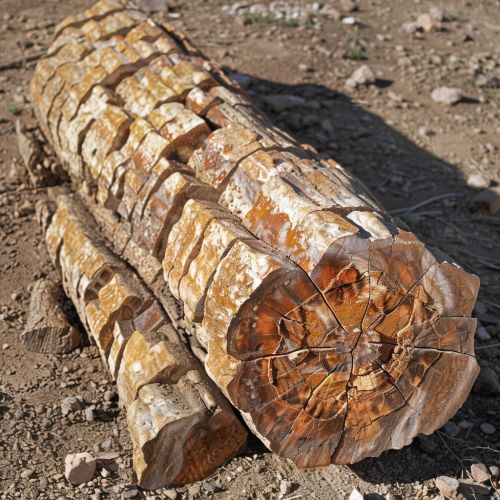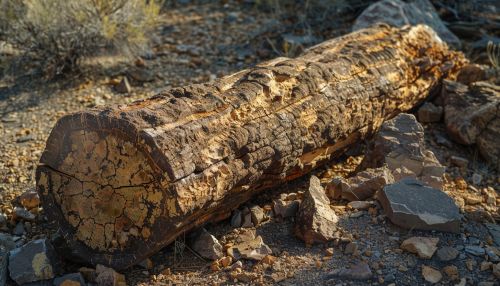Petrifaction
Introduction
Petrifaction, also known as petrification, is a process of fossilization where the organic material of an organism is replaced with minerals, turning it into a stony substance. This process occurs over millions of years under specific geological conditions. The resulting fossils provide valuable insights into the paleontological record, contributing to our understanding of Earth's history and evolution.
Process
The process of petrifaction begins when an organism dies and is quickly buried by sediment. The type of sediment is crucial, as it determines the minerals that will replace the organic material. The most common sediments include volcanic ash and river silt. Over time, the sediment hardens into rock, encasing the organism and creating a protective shell that prevents decay.
The next stage is mineralization. Groundwater seeps into the tiny spaces within the organism, carrying dissolved minerals. These minerals precipitate out of the water and fill the spaces, replacing the original organic material. This process is slow and can take millions of years. The most common minerals involved in petrifaction are silica, pyrite, and calcite.
The final stage is exposure. Over time, erosion wears away the surrounding rock, revealing the petrified organism. This can occur due to natural processes such as wind and water erosion, or through human activities such as mining and construction.


Types of Petrified Fossils
There are several types of petrified fossils, each resulting from different conditions and processes.
Permineralization
Permineralized fossils are formed when minerals fill the pores and cavities of an organism's hard tissues, such as bones or wood. The original material is not replaced, but the fossil is hardened and preserved.
Replacement
In replacement fossils, the original material is completely replaced by minerals. This process is common in shells and other hard tissues. The resulting fossil retains the original structure and detail of the organism.
Recrystallization
Recrystallization occurs when the original minerals of the organism are replaced by more stable minerals. This process can alter the original structure of the fossil, but it often enhances the fossil's durability.
Carbonization
In carbonization, all elements except carbon are removed from the organism's tissues. This process leaves a carbon film that preserves delicate details of the organism. Carbonization is common in plant fossils and soft-bodied organisms.
Examples
Petrified wood is the most common example of petrifaction. It is often found in areas with volcanic activity, where the rapid burial of trees by volcanic ash creates ideal conditions for petrifaction. Petrified wood can preserve the original structure of the tree in remarkable detail, including the growth rings, bark, and cellular structure.
Another example is the Burgess Shale fossils, which are renowned for their exceptional preservation of soft-bodied organisms. These fossils provide a rare glimpse into the Cambrian explosion, a period of rapid evolutionary diversification.
Significance
Petrified fossils are invaluable to the field of paleontology. They provide a record of past life on Earth, allowing scientists to study extinct organisms and reconstruct the history of life. Petrified fossils can reveal details about an organism's anatomy, diet, environment, and behavior.
In addition, petrifaction can preserve organisms that are not normally fossilized, such as soft-bodied organisms. This allows scientists to study a wider range of organisms and gain a more complete understanding of biodiversity in the past.
